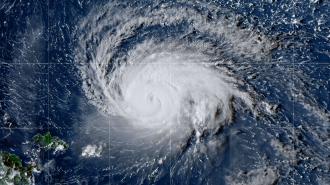AIs developed by some of the biggest names in tech accurately predicted the path of Hurricane Lee a week before it made landfall — a sign that AI models could soon play a major role in weather forecasting.
The European: The “European model” — a computer model developed by the EU-funded European Center for Medium-Range Weather Forecasts (ECMWF) — is largely considered the most accurate model in weather forecasting.
Traditional weather forecasting models take hours to run on supercomputers, which makes them expensive.
To make its weather predictions, it analyzes 60 million daily observations from satellite, aircraft, and ground-based reports, using what we know about atmospheric physics to determine what the weather is likely to be like across the globe over the next 15 days.
This can literally save lives — if people know in advance that hurricanes or winter storms are heading their way, they can take action to prepare — but because the model is so complex, it must be run on a supercomputer over the course of several hours, which also makes it expensive.
The AIs: AI-based weather forecasting models are starting to catch up with traditional ones, like the European Model.
Instead of basing their predictions on atmospheric physics — basically, “if this is what’s happening in the atmosphere right now, this is what the laws of physics say should happen next” — AI models are trained to recognize patterns in historical weather data.
They can then look at what’s happening right now, match it to similar weather conditions in the past, and then predict future weather based on what happened next historically.
AI-based weather forecasting models need just 1 minute to make predictions on standard PCs.
Early research suggests some AI-based weather forecasting models could be as accurate as the European Model, and in June 2023, ECMWF incorporated three of them — Google’s GraphCast, NVIDIA’s ForeCastNet, and Huawei’s PanguWeather — into its operational pipeline.
“The models can now be run from our archived data, the output saved in standardized formats, and they can connect to our verification tools,” wrote the ECMWF.
Using current conditions from the European Model as their starting point, the models need just 1 minute to make their weather predictions, on a standard personal computer — far cheaper and less energy intensive than traditional models.
On track: The ECMWF is only just starting to explore how these AI-based weather forecasting models could be incorporated into global weather forecasting, but their predictions about Hurricane Lee are an encouraging sign.
On September 10, when the hurricane was still in the middle of the Atlantic and thousands of miles away from North America, the AIs predicted it would make landfall in Nova Scotia in about 7 days.
Their forecasts varied only slightly over the next few days, never predicting it would hit farther south than Cape Cod, Massachusetts — and these predictions proved to be about as accurate as ones from the European Model.
“[AI models] could be deployed in a hybrid sense with physical models to verify, augment, and improve the system.”
ECMWF
Past results and future returns: Accurate predictions for one storm aren’t enough to say these AIs are as good as traditional models, and Peter Dueben, head of Earth system modeling at the ECMWF, told MIT Technology Review in July that climate change could affect their accuracy moving forward. Because of changing climate dynamics, the way that weather systems behaved before might not predict how they’ll behave in the future.
If AI-based weather forecasting models are just as accurate, they’ll still need the data collected for traditional models to function, but now that ECMWF has incorporated AI into its pipeline, we could soon see whether two types of models are better than one.
“If ML [machine-learning] can learn to predict the weather, then it could be deployed in a hybrid sense with physical models to verify, augment, and improve the system,” the ECMWF wrote in June. “These recent ML developments further motivate us to continue our hybrid projects as part of the roadmap.”
We’d love to hear from you! If you have a comment about this article or if you have a tip for a future Freethink story, please email us at [email protected].






